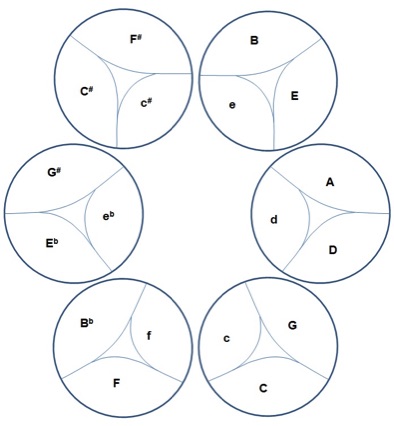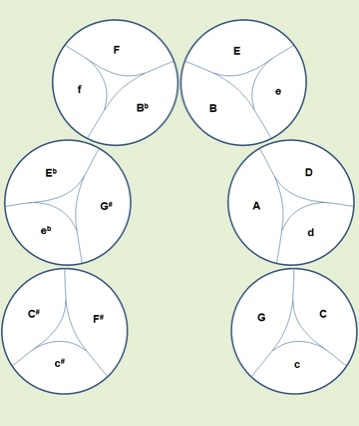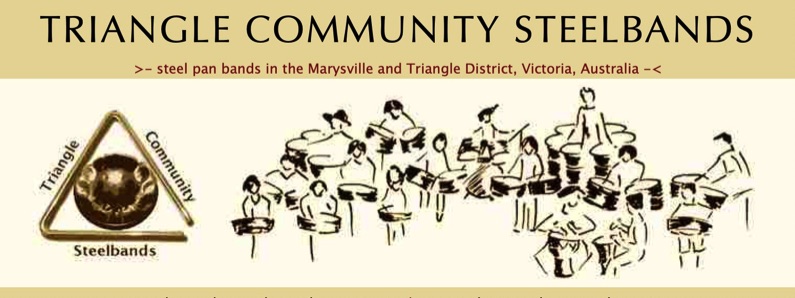Pan Technology
Types of Pans
The Triangle Community Steelbands currently use four different types of steel pan, in addition to percussion:
Sopranos (also called Lead or Tenor)
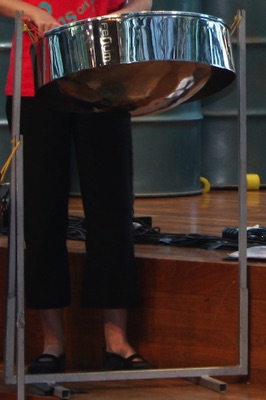
The Soprano pan is also called the Lead or Tenor pan. It is the highest pitched pan in the steelband and usually carries the melody. It is a single drum played by one person. The most common arrangement of notes is a circle of the fifths (described below).
Double Seconds (also called Alto)
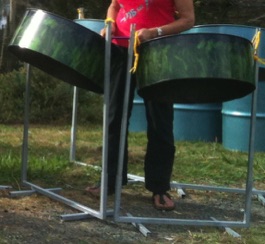
Double Seconds pans are also called Alto pans. They typically play harmony and counter-melodies. Double Seconds are two pans played by one person.
Baritones (also called Double Guitar)
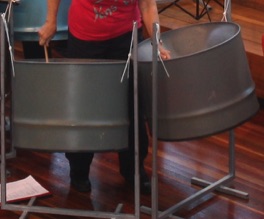
The Baritone (Guitar) pan has the narrowest range and therefore has limited capability for counter-melodies. Their main function is harmonic support usually in the form of strumming chord tones. A Double Baritone is two pans played by one person.
Bass (also called Six Bass)
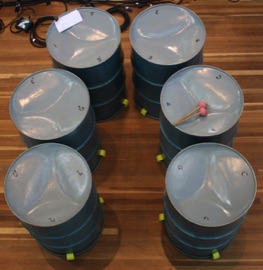
Six drums played by one person, used in conventional steelbands. They are the most popular background pan and are used in steel pan ensembles of all sizes.
In addition there are a number of other popular types of steel pan including the Triple Guitar, the Cello and the Nine Bass.
Percussion
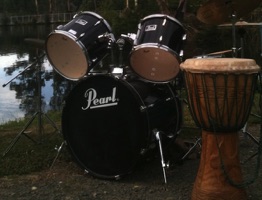
The percussion section can contain a wide variety of instruments including a conventional drum kit, but is often also accompanied by congas, tchembes, scratchers, brake drums, clap sticks, cow bells, tambourines, shakers and maracas.
Layout of the Pans
Many people, especially those who have played piano, often ask why the notes on a steel pan are laid out the way they are, and ask why they are not just laid out in ascending order around the pan (like a circular piano keyboard!). The simple answer to this second question is that unlike a piano (where each note has its own string and hammer to make the sound, independent of any other note), the notes in a steel pan are all connected to each other (since they all reside on the same sheet of steel). When one note is struck, it vibrates and this vibration can be transferred to neighbouring notes. If these notes aren't sympathetic to the struck note, then an unattractive sound can be the result. It so happens that adjacent notes on a piano keyboard do not sound good when played as a chord (try this out for yourself). Therefore, they are not placed together on a steel pan. So the question then remains as to which notes should be put next to each other on a steel pan?
Circle of the Fifths
The answer to this question, for modern steel pans, relies on a piece of music theory conceived by German musician Johann David Heinichen in 1728 - the Circle of the Fifths. To understand this theory, you first need to realise that there are just 12 notes in the musical alphabet - 7 natural notes (A,B,C,D,E,F and G) and 5 sharps and flats (usually called Bb, C#, Eb, F# and G#, but these are the same as A#, Db, D#, Gb and Ab, where "b" is a flat and "#" is a sharp). These 12 notes are arranged in order on a piano keyboard (and just repeated for higher or lower octaves), where the white keys are the natural notes and the black keys are the sharps/flats. Note that not all white keys have a black key between them e.g. E-F and B-C). Starting with a C, the 12 notes are laid out as follows:
1 2 3 4 5 6 7 8 9 10 11 12
C C# D Eb E F F# G G# A Bb B
If we graphically assign each of the 12 notes to the 12 hours of a clock face, starting with C at 12 o'clock and moving 5 notes to the left on the keyboard to get the next hour's note, then G goes at 1 o'clock, Moving 5 more to the left on the keyboard gives us D at 2 o'clock etc. If we continue this pattern until all 12 hours have been assigned notes, we will find that we have also assigned all 12 notes without repetition, as shown below:
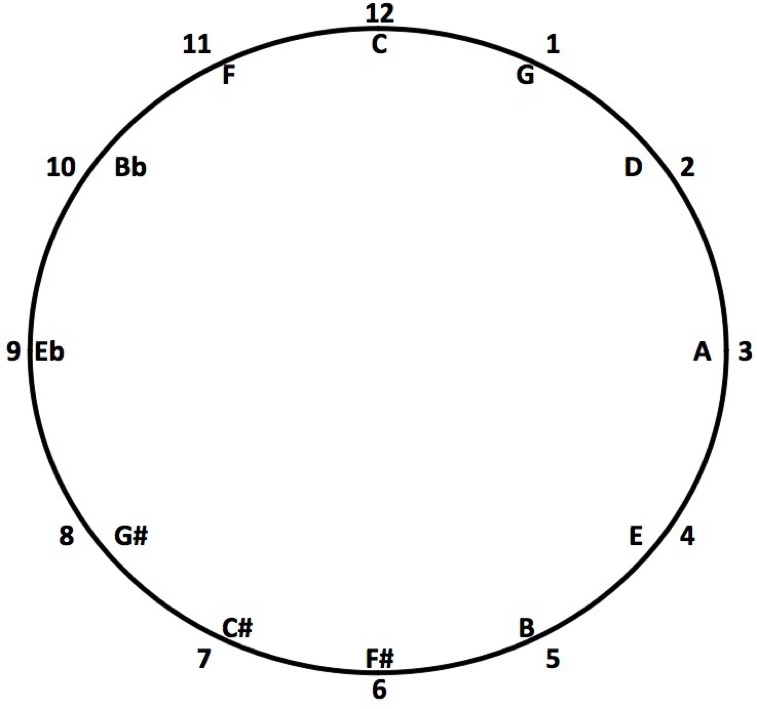
The thing about the "fifths" is that they sound good when played together (try it on the piano), and that is why they are basis for the placement of notes on a steel pan.
Early steel pans had no specific layout of the notes. This all changed in 1953, when Trinidadian Anthony Williams developed the "spider-web" tenor pan, which had the notes laid out according to the Circle of the Fifths shown above. The beauty of this design was that it took a theoretical convention used with many other instruments (of showing the 12 notes on a clockface), and turned it into a physical design for a steel pan. Today's tenor pans look just like the Circle of the Fifth, except that the layout is flipped vertically so that the C is around 6 o'clock (closest to the player) rather than at 12 o'clock, as shown below. Note that the next octave of notes in also laid out in the Circle of the Fifths inside the lower octave, and some of the next octave are then laid out inside these. Thus notes are surrounded by harmonious notes; middle C is surrounded by high C and low C, and by its fifths middle F and middle G.
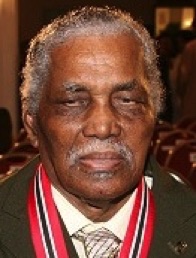
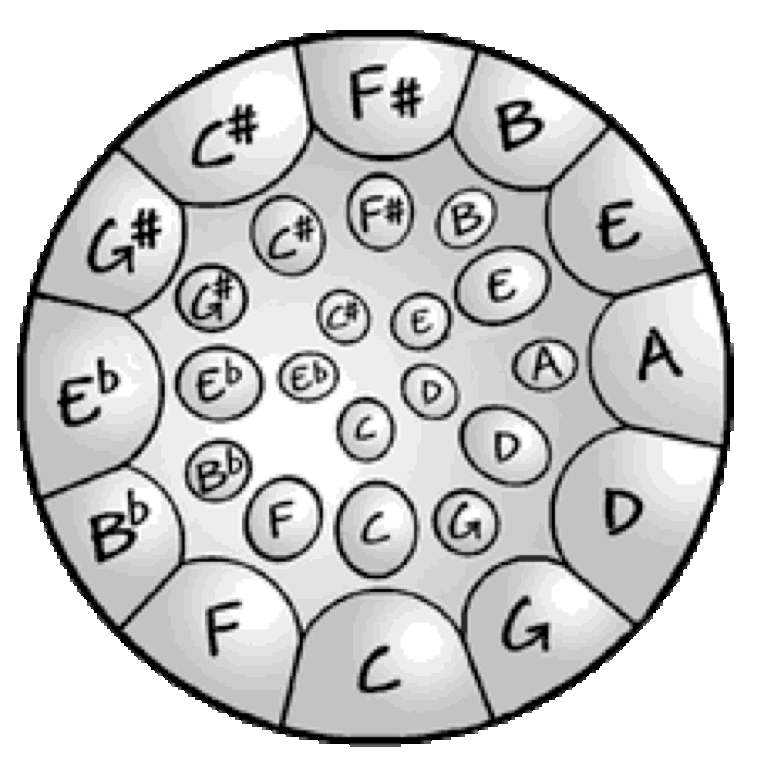
While the Double Seconds and Baritone pans have their own system(s) of note layout, they are still based on grouping notes according to the Circle of the Fifths. The Circle of the Fifths returns more clearly in the Six Bass layout, where it can be seen below at left that by arranging and orienting the bass pans in a certain way, the Circle of the Fifth appears in the outer circle, while some of the higher octave notes appear in the inner circle. Each pan contains three harmonious notes; two fifths and an octave. The detailed design of the Six Bass layout can still vary within these overall parameters; sometimes a different octave note appears on the inner circle, and different players arrange the drums and the orientations to suit their own needs. For example, the Pans on Fire six basses are arranged as shown below at right, with all the natural notes to the front and right side, and all the accidentals to the left.
